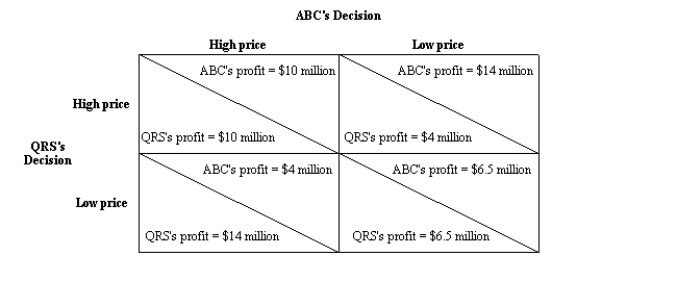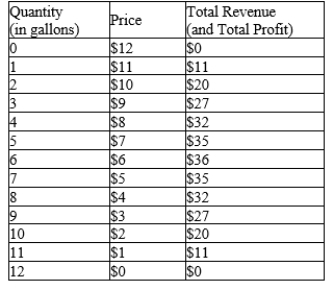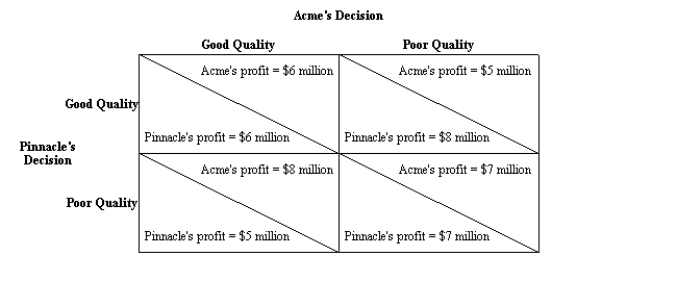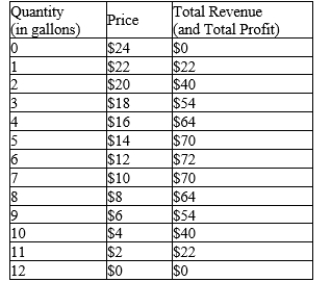A) equals the output level that would prevail in a competitive market.
B) equals the output level that would prevail in a monopoly.
C) exceeds the monopoly level of output, but falls short of the competitive level of output.
D) falls short of the monopoly level of output.
F) A) and C)
Correct Answer

verified
Correct Answer
verified
Multiple Choice
Which of the following statements is correct?
A) When duopoly firms reach a Nash equilibrium, their combined level of output is the monopoly level of output.
B) When oligopoly firms collude, they are behaving as a cartel.
C) In an oligopoly, self-interest drives the market to the competitive outcome.
D) An oligopoly is an example of monopolistic competition.
F) B) and D)
Correct Answer

verified
Correct Answer
verified
Multiple Choice
The players in a two-person game are choosing between Strategy X and Strategy Y. If the second player chooses Strategy X, the first player's best outcome is to select X. If the second player chooses Strategy Y, the first player's best outcome is to select X. For the first player, Strategy X is called a
A) dominant strategy.
B) collusive strategy.
C) repeated-trial strategy.
D) cartel strategy.
F) C) and D)
Correct Answer

verified
Correct Answer
verified
Multiple Choice
Table 17-14
This table shows a game played between two players, A and B. The payoffs in the table are shown as (Payoff to A, Payoff to B) .  -Refer to Table 17-14. Which outcome is the Nash equilibrium in this game?
-Refer to Table 17-14. Which outcome is the Nash equilibrium in this game?
A) Up-Right
B) Up-Left
C) Down-Right
D) Down-Left
F) B) and C)
Correct Answer

verified
Correct Answer
verified
Multiple Choice
Figure 17-5. Two companies, ABC and QRS, are sellers in the same market. Each company decides whether to charge a high price or a low price. In the figure, the dollar amounts are payoffs and they represent annual profits for the two companies.  -Refer to Figure 17-5. If the two companies make their pricing decisions independently, then it is likely that QRS will
-Refer to Figure 17-5. If the two companies make their pricing decisions independently, then it is likely that QRS will
A) charge a low price only if ABC charges a low price.
B) charge a low price only if ABC charges a high price.
C) charge a low price regardless of whether ABC charges a high price or a low price.
D) None of the above are correct.
F) All of the above
Correct Answer

verified
Correct Answer
verified
Multiple Choice
Table 17-2
Imagine a small town in which only two residents, Abby and Brad, own wells that produce safe drinking water. Each week Abby and Brad work together to decide how many gallons of water to pump. They bring water to town and sell it at whatever price the market will bear. To keep things simple, suppose that Abby and Brad can pump as much water as they want without cost so that the marginal cost is zero. The weekly town demand schedule and total revenue schedule for water is shown in the table below:  -Refer to Table 17-2. If this market for water were perfectly competitive instead of monopolistic, how many gallons of water would be produced and sold?
-Refer to Table 17-2. If this market for water were perfectly competitive instead of monopolistic, how many gallons of water would be produced and sold?
A) 12 gallons
B) 8 gallons
C) 6 gallons
D) 0 gallons
F) B) and C)
Correct Answer

verified
Correct Answer
verified
True/False
In a prisoner's dilemma, the Nash Equilibrium might not have a dominant strategy for either player.
B) False
Correct Answer

verified
Correct Answer
verified
Multiple Choice
A cooperative agreement among oligopolists is more likely to be maintained,
A) the greater the number of oligopolists.
B) the larger the number of buyers of the oligopolists' product.
C) the smaller the number of buyers of the oligopolists' product.
D) the more likely it is that the game among the oligopolists will be played over and over again.
F) A) and D)
Correct Answer

verified
Correct Answer
verified
True/False
As the number of firms in a cartel increases, the easier it is to enforce the cartel agreement.
B) False
Correct Answer

verified
Correct Answer
verified
True/False
If firms in an oligopoly agree to produce according to the monopoly outcome, they will produce the same level of output as they would produce in a Nash equilibrium.
B) False
Correct Answer

verified
Correct Answer
verified
Multiple Choice
Scenario 17-5 Assume that a local restaurant sells two items, salads and steaks. The restaurant's only two customers on a particular day are Mr. Carnivore and Ms. Leafygreens. Mr. Carnivore is willing to pay $20 for a steak and $7 for a salad. Ms. Leafygreens is willing to pay only $8 for a steak, but is willing to pay $12 for a salad. Assume that the restaurant can provide each of these items at zero marginal cost. -Refer to Scenario 17-5. If the restaurant is able to use tying to price salads and steaks, what is the profit-maximizing price to charge for the "tied" good?
A) $27
B) $20
C) $19
D) $15
F) C) and D)
Correct Answer

verified
Correct Answer
verified
Multiple Choice
Two CEOs from different firms in the same market collude to fix the price in the market. This action violates the
A) Clayton Act of 1914.
B) Sherman Antitrust Act of 1890.
C) Crandall-Putnam ruling of 1983.
D) Jackson-Microsoft ruling of 2000.
F) A) and C)
Correct Answer

verified
Correct Answer
verified
Multiple Choice
A dominant strategy is one that
A) makes every player better off.
B) makes at least one player better off without hurting the competitiveness of any other player.
C) increases the total payoff for the player.
D) is best for the player, regardless of what strategies other players follow.
F) A) and C)
Correct Answer

verified
Correct Answer
verified
Multiple Choice
Assuming that oligopolists do not have the opportunity to collude, once they have reached the Nash equilibrium, it
A) is always in their best interest to supply more to the market.
B) is always in their best interest to supply less to the market.
C) is always in their best interest to leave their quantities supplied unchanged.
D) may be in their best interest to do any of the above, depending on market conditions.
F) All of the above
Correct Answer

verified
Correct Answer
verified
Multiple Choice
Figure 17-2. Two companies, Acme and Pinnacle, each decide whether to produce a good quality product or a poor quality product. In the figure, the dollar amounts are payoffs and they represent annual profits for the two companies.  -Refer to Figure 17-2. The dominant strategy for Acme is to
-Refer to Figure 17-2. The dominant strategy for Acme is to
A) produce a good quality product, and the dominant strategy for Pinnacle is to produce a good quality product.
B) produce a good quality product, and the dominant strategy for Pinnacle is to produce a poor quality product.
C) produce a poor quality product, and the dominant strategy for Pinnacle is to produce a good quality product.
D) produce a poor quality product, and the dominant strategy for Pinnacle is to produce a poor quality product.
F) All of the above
Correct Answer

verified
Correct Answer
verified
True/False
The problems faced by oligopolies with three or more members are entirely different from the problems faced by duopolies.
B) False
Correct Answer

verified
Correct Answer
verified
Multiple Choice
Table 17-26
Two prescription drug manufacturers (Firm A and Firm B) are faced with lawsuits from states to recover the healthcare related expenses associated with side-effects from its drugs. Each drug manufacturer has evidence that indicates that taking its prescription drug causes liver failure. State prosecutors do not have access to the same data used by drug manufacturers and thus will have difficulty recovering full costs without the help of at least one of the drug manufacturer's studies. Each firm has been presented with an opportunity to lower its liability in the suit if it cooperates with attorneys representing the states.  -Refer to Table 17-26. Pursuing its own best interests, Firm A will concede that taking their prescription drug causes liver failure
-Refer to Table 17-26. Pursuing its own best interests, Firm A will concede that taking their prescription drug causes liver failure
A) only if Firm B concedes that taking its drug causes liver failure.
B) only if Firm B does not concede that taking its drug causes liver failure.
C) regardless of whether Firm B concedes that taking its drug causes liver failure.
D) None of the above. In pursuing its own best interests, Firm A will in no case concede that taking its prescription drug causes liver failure.
F) A) and C)
Correct Answer

verified
Correct Answer
verified
Multiple Choice
Table 17-3
Imagine a small town in a remote area where only two residents, Maria and Miguel, own dairies that produce milk that is safe to drink. Each week Maria and Miguel work together to decide how many gallons of milk to produce. They bring milk to town and sell it at whatever price the market will bear. To keep things simple, suppose that Maria and Miguel can produce as much milk as they want without cost so that the marginal cost is zero. The weekly town demand schedule and total revenue schedule for milk is shown in the table below:  -Refer to Table 17-3. Suppose that Maria and Miguel work together in order to operate as a profit-maximizing monopolist. What price will they charge for milk?
-Refer to Table 17-3. Suppose that Maria and Miguel work together in order to operate as a profit-maximizing monopolist. What price will they charge for milk?
A) $14
B) $12
C) $10
D) $8
F) A) and D)
Correct Answer

verified
Correct Answer
verified
Multiple Choice
The Sherman Antitrust Act
A) was passed to encourage judicial leniency in the review of cooperative agreements.
B) was concerned with self-interest dominated Nash equilibriums in prisoners' dilemma games.
C) enhanced the ability to enforce cartel agreements.
D) restricted the ability of competitors to engage in cooperative agreements.
F) None of the above
Correct Answer

verified
Correct Answer
verified
True/False
Cartels with a small number of firms have a greater probability of reaching the monopoly outcome than do cartels with a larger number of firms.
B) False
Correct Answer

verified
Correct Answer
verified
Showing 201 - 220 of 522
Related Exams